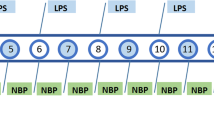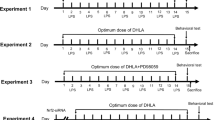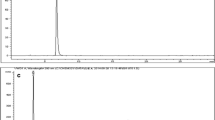Abstract
Objective
To study the antidepressant-like effect and action mechanism of geniposide and eleutheroside B combination treatment on the lipopolysaccharide (LPS)-induced depression mice model.
Methods
Depression mice model was established by lipopolysaccharide (LPS) injection. Totally 48 mice were randomly divided into 6 groups (8 rats per group) according to a random number table, including normal, model, fluoxetine (20 mg/kg), geniposide (100 mg/kg) + eleutheroside B (100 mg/kg), geniposide + eleutheroside B + WAY 100635 (0.03 mg/kg), geniposide + eleutheroside B+ N-methyl-D-aspartic acid receptor (NMDA, 75 mg/kg) groups, respectively. After continuous administration for 10 days, autonomic activity tests after 30 min of administration were performed on the 10th day. On the 11th day, except for the normal group, the mice in the other groups were intraperitoneally injected with LPS (1 mg/kg), and the behavioral tests were performed 4 h later. Enzyme linked immunosorbent assay was used to detect tumor necrosis factor alpha (TNF- α) and interleukin-1 β (IL-1 β) levels in mice serum. The mRNA expression of indoleamine 2,3-dioxygenase (IDO) and nuclear transcription factor (NF- κB) were detected by real-time quantitative polymerase chain reaction. Western-blot analysis was used to detect IDO and NF- κB protein expressions in hippocampus tissue.
Results
Compared with the normal group, a single administration of LPS increased the immobility time in the forced swimming test (FST) and tail suspension test (TST, P<0.01), without affecting autonomous activity. Compared with the model group, fluoxetine and geniposide + eleutheroside B administration significantly improved the immobility time of depressed mice in the FST and TST, decreased serum IL-1 β content, inhibited the expression levels of NF- κ B gene and protein in hippocampus tissues (P<0.05 or P<0.01). Compared with the model group, geniposide + eleutheroside B treatment significantly reduced serum TNF-α content and inhibited IDO mRNA and protein expressions in hippocampus (P<0.05 or P<0.01). In addition, NMDA partly prevented the inhibition of IDO mRNA expression by geniposide + eleutheroside B; NMDA and WAY-100635 also partly prevented the reduction of IL-1 ß content induced by geniposide + eleutheroside B treatment (P<0.05 or P<0.01).
Conclusions
The combination of geniposide and eleutheroside B showed a certain antidepression-like effect. Its main mechanism of action may be contributed to inhibiting the activation of NF- κB, decreasing the proinflammatory cytokines such as TNF-α, IL-1 β, and inhibiting in the neuroinflammatory reaction. Additionally, it also affects tryptophan metabolism, reduces the expression of a key enzyme of tryptophan metabolism, IDO. And this antidepressant-like effect may be mediated by 5-hydroxytryptamine and glutamate systems.
Similar content being viewed by others
References
Baldessarini RJ. The basis for amine hypotheses in affective disorders: a critical evaluation. Arch Gen Psychiatry 1975;32:1087–1093.
Correll CU, Detraux J, De LJ, De HM. Effects of antipsychotics, antidepressants and mood stabilizers on risk for physical diseases in people with schizophrenia, depression and bipolar disorder. World Psychiatry 2015;14:119–136.
Stetler C, Miller GE. Depression and hypothalamic-pituitaryadrenal activation: a quantitative summary of four decades of research. Psychosom Med 2011;73:114.
Leonard BE. Inflammation and depression: a causal or coincidental link to the pathophysiology? Acta Neuropsychiatr 2017;30:1.
Xu XQ, Zong CC. A theoretical study on the treatment of depression with the method of ‘Purging Heart fire and nourishing Kidney water’. Chin J Basic Med Tradit Chin Med (Chin) 2015;25:393–394.
Xu XQ. Therapeutic effect of Eleutheroside senticosus combined with Gardenia on elderly patients with depressive disorder J. Chin J Gerontol (Chin) 2012;32:5383–5384.
Wei XH, Cheng XM, Shen JS, Wang ZT. Antidepressant effect of Yueju-Wan ethanol extract and its fractions in mice models of despair. J Ethnopharmacol 2008;117:339–344.
Yao AM, Ma FF, Zhang LL, Feng F. Effect of aqueous extract and fractions of Zhi-Zi-Hou-Po Decoction against depression in inescapable stressed mice: restoration of monoamine neurotransmitters in discrete brain regions. Pharm Biol 2013;51:213–220.
Zhou L, Wang MN, Zhu X, Cheng H, Wang YX, Du F, et al. Active ingredients, pharmacological actions, and clinical applications of acanthopanax in the central nervous system. J Hunan Univ Chin Med (Chin) 2018;38:961–964.
Koo HJ, Song YS, Kim HJ, Lee YH, Hong SM, Kim SJ, et al. Antiinflammatory effects of genipin, an active principle of gardenia. Eur J Pharmacol 2004;495:201–208.
Zhao C, Zhang H, Li H, Lv C, Liu X, Li Z, et al. Geniposide ameliorates cognitive deficits by attenuating the cholinergic defect and amyloidosis in middle-aged Alzheimer model mice. Neuropharmacology 2017;116:18–29.
Gong X, Zhang L, Jiang R, Wang CD, Yin XR, Wan JY. Hepatoprotective effects of syringin on fulminant hepatic failure induced by D-galactosamine and lipopolysaccharide in mice. J Appl Toxicol 2014;34:265–271.
Huang L, Zhao H, Huang B, Zheng C, Peng W, Qin L. Acanthopanax senticosus: review of botany, chemistry and pharmacology. Pharmazie 2011;66:83–97.
Zhang A, Liu Z, Sheng L, Wu H. Protective effects of syringin against lipopolysaccharide-induced acute lung injury in mice. J Surg Res 2017;209:252–257.
Zhao Y, Li H, Fang F, Qin T, Xiao W, Wang Z, et al. Geniposide improves repeated restraint stress-induced depression-like behavior in mice by ameliorating neuronal apoptosis via regulating GLP-1R/AKT signaling pathway. Neurosci Lett 2018;676:19–26.
Zhou Y, Cheng C, Baranenko D, Wang J, Li Y, Lu W. Effects of Acanthopanax senticosus on brain injury induced by simulated spatial radiation in mouse model based on pharmacokinetics and comparative proteomics. Int J Mol Sci 2018;19:159.
Zhao X, Cao F, Liu Q, Li X, Xu G, Liu G, et al. Behavioral, inflammatory and neurochemical disturbances in LPS and UCMS-induced mice models of depression. Behav Brain Res 2017:S0166432816313250.
Zhang GX, Sun BH. Research on independent activity patterns of mice. Chin Pharmacol Bull 2002;18:464–465.
Porsolt RD. Behavioral despair in mice: a primary screening test for antidepressants. Arch Int Pharmacolodyn 1977;229:327.
Stem L, Chermat R, Thierry B, Simon P. The tail suspension test: a new method for screening antidepressants in mice. Psychopharmacology 1985;85:367.
Alexander C, Rietschel ET. Invited review: bacterial lipopolysaccharides and innate immunity. J Endotoxin Res 2001;7:167–202.
Hosseinizare MS, Gu F, Abdulla A, Powell S, Ziburkus J. Effects of experimental traumatic brain injury and impaired glutamate transport on cortical spreading depression. Exp Neurol 2017;295.
Hamon M, Lanfumey L, El MS, Boni C, Miquel MC, Bolanos F, et al. The main features of central 5-HT1 receptors. Neuropsychopharmacol 1990;3:349.
Francesc A. Serotonin receptors involved in antidepressant effects. Pharmacol Therapeut 2013;137:119–131.
Müller CP, Carey RJ, Huston JP, De Souza Silva MA. Serotonin and psychostimulant addiction: focus on 5-HT1A-receptors. Prog Neurobiol 2007;81:133–178.
Cheetham SC, Crompton MR, Katona CL, Horton RW. Brain 5-HT1 binding sites in depressed suicides. Psychopharmacology 1990;102:544.
Choi D. Glutamate neurotoxicity and diseases of the nervous system. Neuron 1988;1:623–634.
Gasic GP, Hollmann M. Molecular neurobiology of glutamate receptors. Annu Rev Physiol 1992;54:507.
Esra Kü, Melek ZS, Mecit C, Okan KK, Cüneyt ÜM. Zafer G. The change in plasma GABA, glutamine and glutamate levels in fluoxetine- or S-citalopram-treated female patients with major depression. Eur J Clin Pharmacol 2009;65:571–577.
Pochwat B, Paucha-Poniewiera A, Szewczyk B, Pilc A. Nowak G. NMDA antagonists under investigation for the treatment of major depressive disorder. Expert Opin Inv Drug 2014;23:1181–1192.
Jacoby AS, Munkholm K, Vinberg M, Pedersen BK, Kessing L. Cytokines, brain-derived neurotrophic factor and C-reactive protein in bipolar I disorder — Results from a prospective study. J Affect Disorders 2016;197:167–174.
Hoffmann A, Baltimore D. Circuitry of nuclear factor κ B signaling. Immunol Rev 2006;210:171–186.
Li W, Katz BP, Spinola SM. Haemophilus ducreyi lipooligosaccharides induce expression of the immunosuppressive enzyme indoleamine 2, 3-dioxygenase via type I interferons and tumor necrosis factor alpha in human dendritic cells. Infect Immun 2011;79:3338–3347.
Maes M, Mihaylova I, Ruyter MD, Kubera M, Bosmans EJNEL. The immune effects of TRYCATs (tryptophan catabolites along the IDO pathway): relevance for depression and other conditions characterized by tryptophan depletion induced by inflammation. Neuro Endocrinol Lett 2007;28:826–831.
Lovelace MD, Varney B, Sundaram G, Lennon MJ, Chai KL, Jacobs K, et al. Recent evidence for an expanded role of the kynurenine pathway of tryptophan metabolism in neurological diseases. Neuropharmacology 2017;112(Pt B):373–388.
Author information
Authors and Affiliations
Contributions
Xu XQ, Chang HS, Zhang B contributed to the conception and study design. Zhang B contributed to the writing of this article. Zhang B, Chang HS, Hu KL, Yu X and Li LN contributed to conducting the study. All authors read and approved the manuscript for publication.
Corresponding author
Ethics declarations
The authors claim that there is no potential conflict of interest.
Additional information
Supported by the Shandong Key Research and Development Plan (No.2017GSF19112)
Rights and permissions
About this article
Cite this article
Zhang, B., Chang, Hs., Hu, Kl. et al. Combination of Geniposide and Eleutheroside B Exerts Antidepressant-like Effect on Lipopolysaccharide-Induced Depression Mice Model. Chin. J. Integr. Med. 27, 534–541 (2021). https://doi.org/10.1007/s11655-019-3051-5
Accepted:
Published:
Issue Date:
DOI: https://doi.org/10.1007/s11655-019-3051-5




